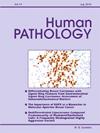PD-L1 expression and immune infiltration across molecular subtypes of endometrial cancer: An integrative-analysis of molecular classification and immune subtypes
IF 2.7
2区 医学
Q2 PATHOLOGY
引用次数: 0
Abstract
The immune subtypes of the tumor microenvironment in endometrial cancer (EC), associated with different molecular classifications, warrant further investigation to guide EC immunotherapy strategies. This study focused on programmed death-ligand 1 (PD-L1) expression (Clone SP263) and immune cell (IC) markers (CD3, CD8, CD68, CD20, CD21) in 110 EC cases. In this cohort, the molecular subtype distribution was: POLE mutation (POLEmut) 7.3% (8/110), mismatch repair-deficient (MMRd) 21.8% (24/110), p53 abnormal (p53abn) 14.5% (16/110), and non-specific molecular profile (NSMP) 56.4% (62/110). NSMP subtypes exhibited the lowest PD-L1+ cell densities and scores. POLEmut and MMRd subtypes showed higher IC densities, while p53abn and NSMP subtypes had lower IC densities and fewer tertiary lymphoid structures (TLS). Integrative analysis of immune subtypes with PD-L1 and CD8+ tumor infiltrating lymphocytes (TILs) revealed 62.5% of POLEmut and 45.8% of MMRd cases as TIME type Ⅰ (PD-L1+ & CD8high). Conversely, p53abn and NSMP cases were more heterogeneous, with 37.5% of p53abn cases in TIME type Ⅲ (PD-L1+ & CD8low) and 41.9% of NSMP cases in TIME type Ⅱ (PD-L1- & CD8low). Higher CD8+ T cell density was a prognostic marker for disease-free survival in EC, including within NSMP (p < 0.05). In summary, the four WHO molecular subtypes of EC exhibit distinct TIME subtypes, complementing molecular classification and providing insights for optimizing EC immunotherapy strategies.
PD-L1在子宫内膜癌分子亚型中的表达和免疫浸润:分子分类和免疫亚型的综合分析
子宫内膜癌(EC)中肿瘤微环境的免疫亚型与不同的分子分类相关,需要进一步研究以指导EC的免疫治疗策略。本研究重点研究了110例EC患者的程序性死亡配体1 (PD-L1)表达(克隆SP263)和免疫细胞(IC)标志物(CD3, CD8, CD68, CD20, CD21)。在该队列中,分子亚型分布为:POLE突变(POLEmut) 7.3%(8/110),错配修复缺陷(MMRd) 21.8% (24/110), p53异常(p53abn) 14.5%(16/110),非特异性分子谱(NSMP) 56.4%(62/110)。NSMP亚型的PD-L1+细胞密度和评分最低。POLEmut和MMRd亚型IC密度较高,而p53abn和NSMP亚型IC密度较低,三级淋巴结构(TLS)较少。免疫亚型与PD-L1和CD8+肿瘤浸润淋巴细胞(til)的综合分析显示,50%的POLEmut和45.8%的MMRd病例为TIME型Ⅰ(PD-L1+和CD8高)。相反,p53abn和NSMP病例的异质性更强,37.5%的p53abn病例为TIME型Ⅲ(PD-L1+ & CD8low), 41.9%的NSMP病例为TIME型Ⅱ(PD-L1- & CD8low)。较高的CD8+ T细胞密度是EC患者无病生存的预后标志,包括NSMP患者
本文章由计算机程序翻译,如有差异,请以英文原文为准。
求助全文
约1分钟内获得全文
求助全文
来源期刊

Human pathology
医学-病理学
CiteScore
5.30
自引率
6.10%
发文量
206
审稿时长
21 days
期刊介绍:
Human Pathology is designed to bring information of clinicopathologic significance to human disease to the laboratory and clinical physician. It presents information drawn from morphologic and clinical laboratory studies with direct relevance to the understanding of human diseases. Papers published concern morphologic and clinicopathologic observations, reviews of diseases, analyses of problems in pathology, significant collections of case material and advances in concepts or techniques of value in the analysis and diagnosis of disease. Theoretical and experimental pathology and molecular biology pertinent to human disease are included. This critical journal is well illustrated with exceptional reproductions of photomicrographs and microscopic anatomy.
 求助内容:
求助内容: 应助结果提醒方式:
应助结果提醒方式:


